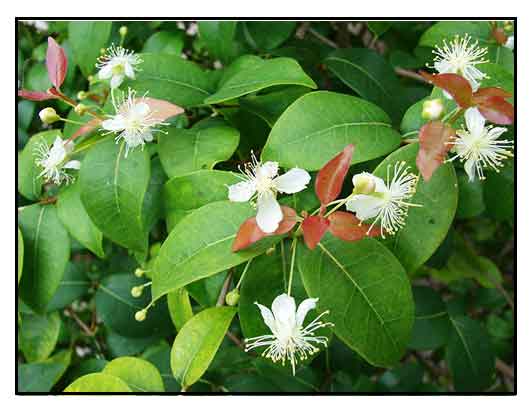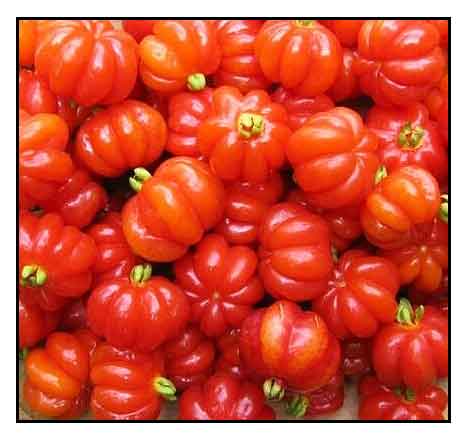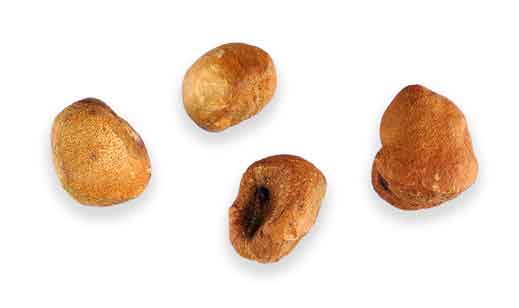 General info General info
- Eugenia uniflora is a flowering plant in the family Myrtaceae.
- The genus contains approximately 1,100 species, the bulk occurring in the New World tropics. (22)
- Molecular phylogenetic studies have changed the historical circumscription of the genus.
Many of the species in the Old World have been reclassified into the genus Syzygium. (22)
- The genus was named in honor of Prince Eugene of Savoy.
Botany
Eugenia uniflora is a large shrub or small tree with a conical form, growing 6 to 12 meters tall. Leaves are without stipules, ovate, glossy, in opposite pairs New leaves are bronze, copper, or coppery-pinkish in color, maturing to deep glossy green, up to 4 centimeters long ,Flowers have four white petals born on slender long stalks, with a conspicuous central cluster of white stamens ending in yellow anthers. Flowers develop into ribbed fruits. Fruit is a drupe, 2 to 4 centimeters long, green when young, becoming orange, scarlet, maroon, or dark red on ripening, and containing 1 to 2 seeds. (8)
Distribution
- Introduced.
- Native to Argentina Northeast, Argentina Northwest, Bolivia, Brazil Northeast, Brazil South, Brazil Southeast, Paraguay, Uruguay. (1)
- Often used in gardens as a hedge or screen.
- Usually introduced as ornamental, it has become invasive in some countries.
C onstituents onstituents
- Preliminary phytochemical analysis of leaves have yielded alkaloids,, triterpenes, flavonoids, and anthraquinones. Studies have isolated hydrolysable tannins (eugiflorins D1 and D2, camptothin A, oenothein B, gemin D, hippomanin A), flavonoids (afzelin, desmanthin-1, myricitrin, quercitrin, and glycosides of myricetin and quercetin), and terpenoids (β-sitosterol, betulinic acid, and centelloside C). (3)
- GC-MS analysis of leaf essential oil yielded oxygenated and non-oxygenated sesquiterpenes as major components, which were identified as germacrenes 5-7, and seline-1,3,7-(11)-trien-8-one oxide 3. (see study below) (6)
- Phytochemical screening of dried and powdered branches yielded coumarins, terpenes and sterols in the hexane extract, while tannins and flavonoids were detected in an ethyl acetate and ethanol extract. There was absence of saponins, alkaloids, and anthraquinones. Total phenolic content varied from 0.59 to 5.56 g/100g and flavonoid ranged from
0.05 to 1.82 g/100 g. (see study below) (10)
 - Phytochemical screening of leaf extracts yielded secondary metabolites viz. alkaloids, tannins, flavonoids, saponnis, steroids, terpenoids and glycosides. (see study below) (14) - Phytochemical screening of leaf extracts yielded secondary metabolites viz. alkaloids, tannins, flavonoids, saponnis, steroids, terpenoids and glycosides. (see study below) (14)
- Study reports on first synthesis of selina-1,3,7(11)-trien-8-one, a major constituent of essential oil from leaves of E. uniflora.
(17)
- Nutrient analysis, raw pitanga (surinam cherry) per 100 g (3.5oz): Energy 138 kJ (33 kcal); carbohydrates 7.49 g; fat 0.4g; protein 0.8g; (Vitamins) vitamin A equiv. 75µg, thiamine (B1) 0.03 mg, riboflavin (B2) 0.04 mg, niacin (B3) 0.3 mg, vitamin C 26.3 mg, (Minerals) calcium 9 mg, iron 0.2 mg, magnesium 12 mg, phosphorus 11 mg, potassium 103 mg, sodium 3 mg; (USDA) (8)
- Study of plant for essential oil identified 32 compounds constituting 92.65% of total oil composition. Most abundant components were sesquiterpenes (91.92%), with curzerene (47.3%), Y-elemene (14.25%) and trans-ß-elemenone (10.4%). (see study below)
(21)
- An activity-guided fractionation of an ethanolic leaf extract isolated two flavonol glycosides, elucidated as myrcitrin (1) and a new compound, 5,7-dihydroxy-3-(3,4,5-trihydroxy-6-methyltetrahydropyran-2-yloxy)-2-(2,4,5-trihydroxyphenyl)chromen-4-one, named “unifloratrin (2). (see study below) (23)
- Study of leaves for essential oil identified 12 compounds:
trans-β-ocimene, cis-β-ocimene, caryophyllene, allo-aromadendrene, β-copaene, α-muurolene, (+)-δ-cadinene, spathulenol, viridiflorol, Isolongifolene, 9,10-dehydro-, α-epi-cadinol and cis-Dihydro-α-copaene-8- ol. (see study below) (26)
 Properties Properties
- Studies have suggested antioxidant, anti-inflammatory, antibacterial, antinociceptive, antiproliferative, antimutagenic, mutagenic, hypotensive, hepatoprotective, anti-trypanosomal, anti-leishmanial, diuretic, neuroprotective, bio-insecticidal properties.
Parts used
Leaves, fruits.
Uses
Edibility
- Fruit is edible, with taste ranging from sweet to sour. Dark red to black fruits are sweet, while green to orange fruits are tart. (8)
- Fruit used as flavoring, or base for jams and jellies.
(8)
- In Uruguay, leaves used in making tea.
(8)
Folkloric
- No reported folkloric medicine use in the Philippines.
-
In South American traditional medicine, use to treat high blood pressure, heartburn, bronchitis, colic, and stomachaches. (4)
- Decoction of leaves used for fever, rheumatism, dysentery, and diabetes. (4)
Others
- Cosmetics: In Brazil, leaf essential oil used in the cosmetic industry for its astringent properties, which are associated with its pleasant smell; used for shampoos, hair conditioners, soaps, body oils, and perfumes (5)
- Repellent: In Brazil, leaves are spread on floors and crushed underfoot, to exude a smell that repels flies. (8) (see study below: 27)
 Studies Studies
• Antioxidant / Anti-Inflammatory / Antinociceptive / Antibacterial / Leaves: Study evaluated crude extracts and fractions of E. uniflora leaves for anti-inflammatory, antibacterial, and analgesic activities in male Swiss mice model. The crude extract showed lower MICs than fractions, including lowest MIC against MRSA strain. The CE and AqF significantly reduced leukocyte migration and MPO activity (p<0.05). The AqF also significantly reduced IL-1ß and TNF-α levels (p<0.05). The CE and fractions exhibited antioxidant effect (p<0.05) and peripheral analgesic effect (p<0.05.). HPLC-DAD yielded varying concentrations of gallic acid, ellagic acid and myricitrin the the CE and fractions. (3)
• Antiproliferative / Mutagenic / Antimutagenic / Leaves and Fruits: Study evaluated the antiproliferative mutagenic, and antimutagenic effects of leaves and fruits through the Allium cepa test. The aqueous extract and oil of E. uniflora exhibited mutagenic activity at low concentrations; at higher than average concentration, the extract is antimutagenic. Both juice extracts with and without seeds have anti-proliferative capacity. (4)
• Flavonoids / Protective Against Murine Sepsis / Leaves: A flavonoid-rich fraction (HE-Bu) from leaves decreased the lethality induced cecal ligation and puncture (CLP), a clinically relevant model of sepsis. Oral He-Bu reduced late mortality rate by 30%, prevented neutrophil accumulation in lungs, decreased TNF-α and IL-1ß serum levels, and markedly decreased iNOS and COX-2 protein expression in ileum cells. Myricetin and quercetin rhamnosides were the major component of the fraction. Results showed potential as adjuvant treatment for sepsis. (5)
• Antioxidant / Antimicrobial / Essential Oil of Leaves: Essential oil of leaves was evaluated for antioxidant, antibacterial, and antifungal properties. The EO showed antimicrobial activity against two important pathogenic bacteria, S. aureus and Listeria monocytogenes, and against two fungi, Candida lipolytica and C. guilliermondii. On acute oral toxicity study, the EO (10-200 mg/kg) did not cause lethality or toxicological effects in mice. The EO exhibited antioxidant activity in DPPH, ABTS and FRAP assays and reduced peroxidation in kidney of mice. (see constituents above) (6)
• Dual Cardiac Effects / Hypotensive: Study evaluated the effect of aqueous crude extract (ACE) on rat's perfused ventricles. Results suggested a negative-inotropic compound in the extract, along with an irreversible Ca-blocking compound. The ACE has a dual effect on the heart related to a hypotensive action, probably responsible for the therapeutic or adverse effects in patients under cardiac risk. (7)
• Dental Dentifrice for Gingivitis / Antibacterial / Clinical Trial : School children are at high risk for onset of biofilm-dependent conditions, including dental caries and periodontal diseases. This randomized trial evaluated the clinical efficacy of dentrifice containing E. uniflora extract vs a triclosan-based comparator in treating gingivitis in children 10-12 years of age. The experimental dentrifice showed efficient antibacterial activity in vitro. The E. uniflora dentrifice showed anti-gingivitis properties and suggests a potentially efficient and safe product for preventive dental practice. (9)
• Analgesic / Anti-Inflammatory / Antioxidant / Branches: Study evaluated various extracts of branches for in-vitro and in-vivo bioactivities. Extracts showed anti-inflammatory activity with reduction of paw edema after carrageenan application. Extracts showed antinociceptive activity by decreased number of writhes and phases of paw licking time, with increase in reaction time on hot plate test. (see constituents above) (10)
• Diuretic / Leaves: Study evaluated a total aqueous extract and major fraction of leaves for diuretic activity in mice. Results showed statistically significant diuretic action by the crude extract (0.24 mg/kg; p<0.05) while the major fraction exhibited diuretic activity (0.24 mg/kg; p<0.08). (11)
• Anti-Trypanaosoma cruzi / Cytotoxicity: Chagas disease is caused by Trypanosoma cruzi. Study evaluated an ethanolic extract from E. uniflora for in vitro anti-epimastigote and cytotoxic activity.. A concentration with an EC50 activity was 62.76 µg/mL. MIC was ≤1024 µg/mL. Results suggest a potential source of plant derived natural product with anti-epimastigote activity with low toxicity. (12)
• Antibacterial / Leaves: Study evaluated aqueous, organic, and volatile oil extracts of leaves of Eugenia uniflora for antibacterial activity using agar dilution techniques. The aqueous extract showed most active activity, inhibiting Gram positive S. aureus and B subtilis and gram negative E. coli and Shigella dysenteriae. (13)
• Antioxidant / Leaves: Study evaluated the phytochemical constituents and free radical scavenging activity of various E. uniflora leaf extracts by DPPH, FRAP, ABTS and total antioxidant assays. While all extracts exhibited free radical scavenging activity, the ethanolic extract showed higher activity. (see constituents above) (14)
• Hepatoprotective / Antioxidant / Polyphenol-Rich Fraction: Study evaluated the effect of E. uniflora on carbon tetrachloride (CCl4)-induced acute liver injury in rats. Bioguided fractionation assay showed an ethyl acetate fraction (EAF) to be the safest and most active fraction. LC-MS analysis of EAF yielded 27 secondary metabolites, mainly myricetin and quercetin derivatives. EAF did not show toxicity up to 2000 mg/kg and exhibited in vitro antioxidant activity in DPPH assay with IC50 of 3.35 µg/mL. The EAF significantly inhibited CCl4-induced elevation of ALT, AST, total bilirubin, TC and TG, and prevented lipid peroxidation and restored SOD activity and GSH content in liver tissues. Pretreatment effectively attenuated CCl4-induced histopathological changes. The hepatoprotective effect was attributed to its antioxidant activity. (15)
• Neuroprotective / Prevention of Episodic Memory Impairment Induced by Streptozotocin: Study evaluated the neuroprotective effect of an ethanolic extract of E. uniflora leaves on memory impairment induced by STZ in rats. Animals were tested in elevated plus maze to assess learning and memory. STZ group showed higher transfer latency (p<0.001) which impaired memory The leaf extract of E. uniflora showed a neuroprotective effect on memory impairment induced by STZ. The effect was attributed to antioxidant and anti-inflammatory properties. (16)
• Potentiation of Antibiotic Activity of Gentamicin: Study reports on the modifying activity of Eugenia uniflora and E. jambolanum. The ethanol extract of E. uniflora and E. jambolanum did not inhibit the growth of strains of E. coli. The MIC was ≥1,024 µg/mL for both strains of E. coli assayed. Synergism between this extract and gentamicin was demonstrated. The extract also exhibited synergism with chlorpromazine and kanamycin and between amikacin and tobramycin, indicating the involvement of an efflux system in the resistance of the aminoglycosides Results suggest potent for a pant-derived product with modifying antibiotic activity. (18)
• Effect on Protein Global Expression during Morphogenesis in Candida albicans: Study evaluated by proteomic analysis the role of a Eugenia uniflora in impairing hypha formation in Candida albicans and its potential action in preventing and treating oral candidiasis in a murine model of oral infection. Results showed the EAF greatly reduced hypha formation after morphogenesis induction. The EAF surprisingly significantly reduced phagocytosis in C. albicans. Oral candidiasis was attenuated when C. albicans cells were either preincubated in the presence of E. uniflora or when the fraction was applied to the surface of the oral cavity after infection. E. uniflora may act of essential proteins to reduce the capacity of filamentation and attenuating infection in a murine model without toxic effect on human cells. Results suggest potential for a therapeutic alternative for the treatment of Candida albicans. (19)
• Antiproliferative / Leaves: Study evaluated the antiproliferative effects of hydroethanolic (HEE) and dichloromethane (DEE) extracts of leaves of E. uniflora against a panel of human tumor cell lines in vitro. HPLC identified quercetin, and ß-sitosterol was isolated. HEE was inactive while DEE showed antiproliferative activity against OVCAR-3 ovarian cells. ß-sitosterol from DEE showed potent antiproliferative effects against glioblastoma (U-251 cells) and leukemia (K-562 cells). Results suggest ß-sitosterol is a potential chemotherapeutic compound. (20)
• Anti-Leishmaniasis / Essential Oil: GC-MS analysis evaluated the composition of essential oil of E. uniflora and its anti-leishmanial activity. The bioactivity of EO against promastigotes (IC50 3.04 g/mL) and amastigotes (IC50 1.92 g/mL) suggested significant anti-leishmanial activity. In cytotoxicity evaluation, EuEO was 20 times more toxic to amastigotes than to macrophages. Macrophage activation may be involved in the EO anti-Leishmania activity, as evidenced by increase in both phagocytic capacity and lysosomal activity. (21)
• Flavonol Glycosides / Myricitrin / Cytotoxicity / Antioxidant / Anti-Inflammatory / Leaves: An activity-guided fractionation of an ethanolic leaf extract isolated two flavonol glycosides, elucidated as myrcitrin (1) and a new compound, 5,7-dihydroxy-3-(3,4,5-trihydroxy-6-methyltetrahydropyran-2-yloxy)-2-(2,4,5-trihydroxyphenyl)chromen-4-one, named “unifloratrin (2). Myricitrin showed cytotoxicity against HeLa cells with CC50 of 8.5 µg/100 mL, comparable to standard 5-FU (5-fluorouracil). It exhibited better antioxidant activity with IC50s of 6.23, 22.01, and 30.46 µM against DPPH, NO, and H2)2 free radicals, respectively. At 20 µg/mL, myricitrin showed anti-inflammatory activity comparable to diclofenac. Results suggest potential for myricitrin as cytotoxic agent. (23)
• Anti-Inflammatory / Analgesic / Leaves: Study evaluated the anti-inflammatory, analgesic, hematological and histological effects of ethanol extract of E. uniflora. The extract decreased paw volume and thickness. There was dose-dependent significant (p<0.05) decrease in the number of abdominal writhing and insignificant reducion in second or late phases of formalin-induced licking test group. Histological exam showed aggregation of inflammatory cells in skin sections. Results showed potent anti-inflammatory and analgesic effects comparable to Ibuprofen, an NSAID, and justifies its use in treatment of inflammation and local tissue injury. (24)
• Glycemic Control / Prevention of Diabetes / Review and Meta-Analysis
: Review and meta-analysis evaluated the effects of E. uniflora on glycemic control and prevention of DM complications. Three preclinical trials in vivo trials were included in the systematic review and two in the meta-analysis. All studies demonstrated beneficial results in glycemic control, an prevention of complications related to DM. Effects were attributed to chemical composition, which is rich in phenolic compounds with antioxidant and anti-inflammatory properties. (25)
• Essential Oil / Antibacterial / Leaves: Study of leaves for essential oil identified 12 compounds. Most of the identified compounds were sesquiterpenes. EO showed antibacterial activity against strains of E. aerogenes and S. typhimurium. Results suggest a potential natural source of new drugs. (see constituents above) (26)
• Bio-Insecticidal / Toxicity to Drosophila melanogaster (Common fruit fly) / Essential Oil of Leaves: Study evaluated the toxicity induced by E. uniflora leaves essential oil in a Drosophila melanogaster model. Exposure of adult flies to the essential oil via a fumigant method resulted in increased mortality and locomotor deficits. There was also oxidative stress response signaling, evidenced by changes in ROS production, lipid peroxidation, alterations in antioxidant enzymes and expression of Nrf2 protein targets. Results suggest potential bio-insecticidal activity. (27)
Availability
- Wild-crafted.
|

![]()



 General info
General info
 - Phytochemical screening of leaf extracts yielded secondary metabolites viz. alkaloids, tannins, flavonoids, saponnis, steroids, terpenoids and glycosides. (see study below) (
- Phytochemical screening of leaf extracts yielded secondary metabolites viz. alkaloids, tannins, flavonoids, saponnis, steroids, terpenoids and glycosides. (see study below) ( Properties
Properties
